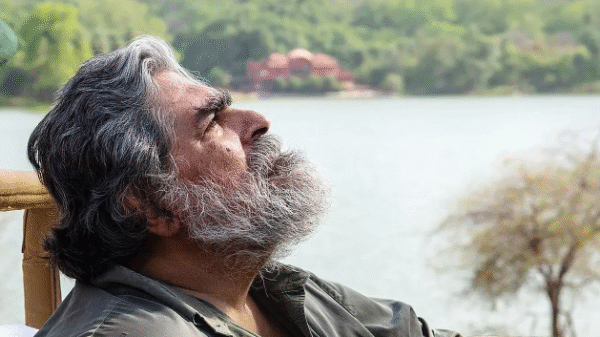The conservationist and ardent campaigner died on May 31st, aged 73

Once seen, he was not easily forgotten. In his kingdom, the national tiger reserve of Ranthambore in Rajasthan, he patrolled night and day, solitary, guarding what was his. His shoulders were broad, his girth impressive; he exuded power and purpose. A thick ruff of hair grew on his cheeks, and his eyes bored and blazed. No one registered more intently the trail of pug-marks or the flocking of vultures; the deer sucking up water-plants from the shallows of Rajbagh Lake, their antlers flat among the lotus flowers, and the crocodiles that pulled them under; each piglet-rustle in the tall grass. His speed, when he charged, was terrifying. Many of his kind were lazy, but not he; day and night he paced his territory, fearless and often roaring.
His name was Genghis. But anyone who mistook him for Valmik Thapar would not have been wrong. Mr Thapar admitted that he was obsessed with him; from their first mutual glance, he moved in his skin. The Ranthambore reserve was indeed his domain, all 392 square kilometres of it, and his life was completely entangled with the tigers who, for five decades, he fought to protect. Throughout India (for his love encompassed all its tigers) he was known as “Tiger Man”. In almost 30 books and tv documentaries he spoke in the tiger’s booming voice. And many were the government ministers, the forest wardens and the state jobsworths who, at some encounter or another, had felt the furious glare of those eyes and dreaded the inevitable charge.
The urgency of his campaign was obvious. In 1900 around 100,000 tigers had roamed India. By 1973, through a combination of plunder, agriculture and maharajas’ shooting sprees, their numbers had fallen to 1,800. That year Indira Gandhi, then prime minister, set up Project Tiger, establishing nine national reserves manned with guards. As a result the population had stabilised, but still at a desperately low level. Poachers continued to raid the reserves for lucrative tiger pelts, bones and bits to send as medicine to China. Local villagers and tribal people, deprived now of access to ancestral grazing land, wood and water, saw tigers as their enemy. India took great pride in tigers; they were the national animal. But relations between them and humans were often dire.
Mr Thapar had no idea he would take on such a role. His family were part of the Punjabi elite in New Delhi, intellectuals, army officers and friends of the Gandhis; he saw his first tiger, at ten, when majestically astride an elephant. His next sighting, though, was under very different circumstances. His first marriage had gone wrong, attempts at a career were stalling, and he went to Ranthambore to try to find healing. It came in the sprightly form of Fateh Singh Rathore, the wildlife warden, with his Stetson hat and elegant moustache, who introduced him to the delights of a life spent largely in a jeep, keeping as quiet as possible, waiting for the sheer joy of a glimpse of stripe, a tip of an ear above the grass, or a flicker of a tail: tiger-watching.
This was love from the beginning. The rarity of sightings—perhaps one every two weeks—added to the allure. For most of the day the tigers slept, perfectly camouflaged by tall grass and tree-shadows. At sundown they were on the move. In time he could sense them before he saw them, partly from the highly accurate panic-cries of peacocks but also from his own instinct, grown keen as an animal’s. He observed and recorded the activities of 125 tigers, but some were family. Calm, elegant Padmini, the Queen Mother of the jungle; Akbar, a confident risk-taker; Noon, who spread her favours between two males; Nasty, who threatened to attack each jeep as it passed her. And Ghengis, whose imperiousness included refusing to be watched while he ate.
Some of Mr Thapar’s findings surprised him. He saw male tigers bringing up motherless cubs, rather than devouring them, and making successful deer-kills in water. He also saw them (Ghengis again) sparring over carcasses with crocodiles, and usually winning. As the years passed he could draw closer and closer to tigresses with young, watching the little ones roll stones or chase after butterflies. The beauty of these creatures never failed to move and amaze him.
His task, then, was to spread the word in his writings and documentaries (”Land of the Tiger”, for the bbc in 1997, was the best known) and to keep their plight in India’s eye. Whenever he was not in the forest he tended to be prowling the corridors and anterooms of government, looking for prey. He reckoned he had sat on 150 committees, almost all rife with sloth and indifference. His action plan was small and sharp: inviolate space for tigers, far from noise and humans; properly armed local wardens who would enforce the law; and forest services run at state, not national, level.
In the villages around the reserve, however, he faced fury from the people who felt they had lost out to tigers. Here his tactics were gentler. He set up a foundation to encourage conservation in 100 perimeter villages, as well as a co-operative craft society and a school of art. Eventually, admitting that “inviolate space” was too optimistic, he spoke up for properly managed tourism, and hoped to see scientists, villagers and state officials serving tigers together. The bottom line, he reminded villagers, was that without its apex predator the forest itself would not survive.
The unique feature of Ranthambore was an ancient fort from which, in the past, successive rulers had controlled central India. It was in ruins now, but many of his sightings of tigers took place among its crumbling walls. His friends made dens there, and dragged their kill there to eat. He meanwhile made his den on the terrace of an adjacent temple, now a rest house, drinking whisky as the sun went down. The landscape was filled with evening calls, each one of which he knew. Soon he would begin to patrol in the deepest possible silence; but the reverberation of his roaring still echoed, both in his head and in the forest. ■



















